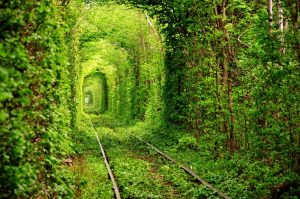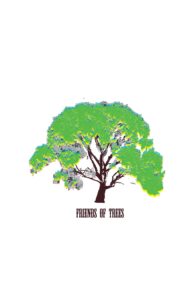At the Root: Trees Rule
By Guest Blogger: Eileen Stark, Portland, Oregon

By Guest Blogger: Eileen Stark, Portland, Oregon

Humans and other species thrive on oxygen. Trees and other plants create oxygen. So, you’d think if we wanted to live long, healthy lives and save other species – we’d plant as many trees as possible. Big trees also give off more oxygen than young trees – so, leaving big trees standing also makes sense for oxygen production. 
If you’ve ever been in a plant store or the middle of a forest you know how good it feels to be breathing higher concentrations of oxygen.
So, for greater planetary health and better longevity – plant trees whenever possible and work to stop trees from being cut down everywhere. The End
Well, not exactly. So, the thoughts above came from me mulling over a friend who has a tree in her front yard and two trees in her planting strip out front. She’s got yellow tags circling all three – and mentioned that the 2 trees in the planting strip are not well and that the big tree out front threatens her house.
I hope you’ll reconsider when you think about removing a tree for some good reason. Tree companies who come out to talk trees make money from the tree removal. The Urban Forestry folks at the City of Portland are also not in the business of keeping trees standing and we’re losing Portland’s canopy at an alarming rate. Mature trees are Biocarbon Heavyweights.
If you’re interested in this topic – we have a group on Facebook organized to keep tall trees standing. As well as an email list for this topic. Thanks for your consideration.
Oh, and plant trees (see above) – fruit trees, nut trees, shade trees – Friends of Trees is a great place to start.
Here’s to your health and our planet’s health.

3.19.18: Eileen writes: “Yes and don’t forget about carbon sequestration. And that regional native trees provide more food and other habitat for wildlife.”

We had a great tree planting in Irvington, Sabin, Grant Park, and Alameda neighborhoods last weekend (March 10, 2012). thanks are in order! Here are some of the folks we want to thank!
I’m sure there are more people to thank, please feel free to add them into the comment section. And, I’ll add more pictures here as they come in! Thanks, everyone for your help in adding to Portland’s canopy.
This year’s planting featured the volunteer effort of many young people. I’ve never seen that many young people volunteering together before – it was impressive. Someday I hope that these young people will come back and visit the trees they planted and smile.

mmm, good morning world. I had a great adventure yesterday and am feeling revived and refreshed by it. I spent the day with Duane and Melani who run Summer Lake Hot Springs Resort in Paisley, Oregon. We traveled together to Nehelam where Duane wanted to show me land he had purchased 14 years ago and which he’ll learn more about the fate of today when he meets with investors who supported the purchase. It’s about 10 acres and it has a view of Saddle Mountain and the coastal range looking north. We drove out rt. 53 to get there, and stopped along the way to look at a cavernous creek in some light rain. Being in the Tillamook State Forest reminded me of why I spend time trying to defend the place. It’s such a magical land of creeks, rivers, logging roads, ferns, hemlock and undergrowth. And the rain just makes it all the wetter and greener – so magical.
The Tillamook State Forest is Oregon’s biggest and is the subject of much discussion around the area as it has a special place for many. A number of times in the 20th Century the forest burned and because it was the depression there was the CCC and many others (students, particularly) who traveled to the burned areas and replanted the forests. People in Oregon have a special relationship with this forest. Nowadays, the forests are clear-cut by local timber companies and some of the money goes to fund local schools and government services. Unfortunately, due to the lack of nearby mills and market forces the logs mostly are cut and shipped directly overseas, to China, I believe. Since the profits from the logging are tied to local services there is pressure to cut more and more trees thus leaving a landscape that looks trashed.
Lately, our Governor has stated that he is in favor of a more balanced approach that would also take into account environmental factors (there are landslides everywhere) – other species (it’s Spotted Owl and Marbled Murulet country)(and lots of salmon and other fish species) – and recreation (fishing, hiking, camping, white-water rafting). Unfortunately, it’s quite an uphill battle due to the fact that the Oregon Board of Forestry which sets policy for the forests is mostly made up of timber company owners and representatives. I’ve testified before the group numerous times in Salem, and they are not swayed by public opinion at all.
More background on this issue can be found here. And if you’d like to join my Facebook cause page, click here.
We arrived at Duane’s land near Nehelam in a downpour and put on our rain gear and bushwhacked through the property, climbing amongst overgrown blackberry brambles and small trees and bushes. I’d seen pictures of the property in sunshine and I believe the views to the north and west are stunning, but yesterday the view was a wall of rain. And, it felt so invigorating to wander around and be human bushhogs! After about an hour we were all pretty soaked and we got back in the van and made our way to Manzanita with a detour to the town’s “rebuilding center” which is a collection of recycling and 2nd hand store which was a fun side trip.
We followed this up with lunch in Manzanita and then a wonderful drive home full of conversations about land, business, relationships and our personal stories. Duane and Melani are living a dream – living in the Oregon high desert and meeting interesting travelers from all over the world. They both have great perspectives on life and are positive, evolved people. It was such a nice combination to have great conversations and be out in the wilderness and I feel lucky today to have had the adventure! Here’s to life, may we live it big and large and lusciously! And, please join me in learning more about the Tillamook State Forest and how to protect it from greed.
We had a great day planting trees with Friends of Trees on Saturday, March 13th. Starting with our breakfast at the Holladay Park Church early in the morning through a delicious lunch held after the planting – supplied by residents of the Irvington, Grant, Sabin and Alameda neighborhoods.
I want to thank the following people and businesses for their support in our efforts.
Friends of Trees – especially Jesse Batty and Erica Timm who led the day of planting
The neighborhood coordinators for each neighborhood
Neil Davidson – Alameda
Lisa Johnston-Smith – Sabin
Angela Gusa – Grant Park
Albert Kaufman – Irvington
Holladay Park Church – our wonderful host!
Helen Bernhard Bakery – baked goods
Caffee D’arte – Coffee
Starbucks on 15th & B’way – Coffee and more Coffee
Grand Central Bakery – pastries, yum
Costello’s Travel Caffee – pastries, more yum!
Penske Trucks – truck donation
Eric McClelland – Treeform Woodwork – drove to Boring and back to pick up our trees
City of Portland – Bureau of Environmental Services – a huge hand in many ways
Backyard Bird Shop – our main sponsors!
I could write a novella about the task of being a neighborhood coordinator for this event. It’s full of contacting neighbors, reaching out to businesses and interacting with the great staff at Friends of Trees. And, I enjoyed the fun of planting trees even more. Working with great crew leader, Karen, and crew assistant, David, we walked in a 5 block circle and planted 11 trees in 3 hours. This involved pulling the trees out of the truck, unwrapping each, making sure holes were the right size, involving homeowners and their kids, filling the holes in with dirt, and watering and staking them.
It was a rainy day, but our spirits were high. And when we returned to the basecamp, there were all of the other volunteers and crew leaders sitting down to a well-deserved bountiful lunch of soups, chilis, stews, bread, salads and deserts. It was a great time to swap stories, share smiles, and make some new friends beyond the crew that you’d been assigned to.
All in all, I’d say the day was a complete success. We planted 182 trees together and another 30 were planted the following Monday, bringing us to a grand addition of 212 trees for our 4 neighborhoods. These trees will add to the canopy of our neighborhoods – help reduce the amount of water going into the stormwater drains, shade us in the summer, provide us fruit and nuts, look beautiful, increase property values, and increase the safety of our neighborhoods.
If you didn’t get a chance to join us, please consider volunteering with Friends of Trees and see what fun it can be to plant trees in Portland. Also, Friends of Trees is a membership organization and I encourage you to become a member today. They do great work that makes our City more livable and our lives healthier and happier.
One happy tree planter!

In partnership with Friends of Trees, the Irvington, Alameda, Sabin and Grant neighborhoods are planting trees on Saturday, March 12, 2010! Join us at 8:30am at the Holladay Park Church at 2120 NE Tillamook Street to meet friends and create a healthier community! In these challenging times, it’s more important than ever to come together and build our community through our relationships and shared efforts to make our neighborhoods healthier.
For our planting we would appreciate hearing ASAP from anyone with a pick-up truck we can borrow for the day, potluck dishes to arrive at the church around 12pm for lunch for our volunteers; and neighbors who would like to help plant trees. Gloves, shovels and all necessary tools will be provided by Friends of Trees. Young people are especially welcome to join us.
Please contact Albert Kaufman at irvington@plantitportland.org to volunteer for this year’s planting or to start thinking about how we can complete our green canopy over Irvington in 2012. I am particularly interested in seeing us move from lawns to gardens and am all for us planting lots more fruit trees to increase our local foodshed! For more information about Friends of Trees, please visit https://friendsoftrees.org
Reviews for Albert Kaufman Top qualities: Great Results, Expert, High Integrity If you're looking for someone to setup and manage your Constant Contact account, Albert's the guy. He's enthusiastic, creative, and plugged in. He works well with clients, listening to what they want and incorporating … [Read More ...]
Copyright © 2025 · albertideation Child Theme on Genesis Framework · WordPress · Log in